Fatigue Overview of Ship Structures under Induced Wave Loads
Abstract
:1. Introduction
2. Cyclic Loads
- Hydrodynamic loads induced by propulsion equipment on the hull: higher-frequency loads, caused by engines and propellers, resulting in forced vibrations with high number of load cycles, typically 1010 or more [5];
- Loads due to varying loading conditions, cargo loading and unloading: low-frequency loads with very long periods resulting in hundreds to thousands of load cycles during the ship’s operational lifetime [6];
- Waves loads: low-frequency loads usually on the order of 0.1 Hz. Over an operational lifetime of 25 years, the total number of cycles, induced by these loads, may vary between 107 and 108.
2.1. Wave-Induced Cyclic Loads
2.2. Wave Modelling: 1st and 2nd Irregular Wave Theory
2.3. Frequency-Domain Spectra
2.4. Time-Domain Series
2.5. Wave-Induced Ship Response: Strip Theory
3. Fatigue Strength Assessment Approaches
3.1. Simplified Deterministic Method
3.2. Direct Calculation Method
- Transform the stress history: Begin by plotting the stress time history of the material or structure, typically in the form of a stress–strain curve. The stress is plotted on the vertical axis, while time or load cycles is plotted on the horizontal axis.
- Identify peaks and valleys: Identify all the local maxima (peaks) and minima (valleys) in the stress history. These points are critical as they represent the potential turning points where stress cycles begin and end.
- Rainflow counting process: Imagine the stress time history is a mountain range with rainwater flowing down the slopes. The “rainflow” process then involves tracing the flow of this “water” from each peak or valley, pairing it with corresponding valleys or peaks that represent the completion of a stress cycle. Specifically, from each peak, “water” flows downhill to the next valley, unless it encounters a higher peak or lower valley on the way, in which case the cycle is terminated and a new cycle begins. Each completed flow from a peak to a valley, or from a valley to a peak, is counted as one half-cycle. Two half-cycles are paired to form a full cycle.
- Cycle counting and stress range: Once all possible flows have been traced, count the number of full cycles and half-cycles. For each cycle, calculate the stress range, which is the difference between the peak and valley stresses. Record these cycles and their corresponding stress ranges, as they represent the loading history the material has experienced.
- Histogram construction: The final step is to create a histogram or matrix that shows the number of cycles for each stress range. This data can then be used in fatigue analysis to estimate the cumulative damage using methods such as Miner’s rule, which relates the number of cycles to the material’s fatigue life.
3.2.1. Frequency-Domain Analysis
- Linear wave theory: Irregular waves are modelled as a combination of regular wave components, with their energy described by a short-term wave spectrum.
- Linear relationship: A linear relationship exists between the waves and the ship’s structural response, which allows for the use of transfer functions to describe the ship’s dynamic characteristics.
- Narrow-band approximation: Stress ranges within each short-term sea state are assumed to follow a Rayleigh distribution, with cycle counting based on the zero up-crossing period of short-term structural stress responses. It should be noted that this assumption is not applied in the hybrid method.
- Stress concentration factors (SCFs): These factors adjust for increased stress around features such as welds and notches, highlighting areas prone to higher stress and potential fatigue issues.
- Wave load coefficients: These coefficients describe the magnitude and distribution of forces exerted by waves on the structure, essential for modelling the actual loading conditions experienced by the ship.
- S–N curves (stress–number of cycles): These curves illustrate the relationship between cyclic stress amplitude and the number of cycles to failure for a material, helping to estimate the fatigue life of structural components under different stress conditions.
- Material properties: Characteristics such as Young’s modulus, yield strength, ultimate tensile strength, and fatigue strength define how well the material can endure cyclic loading without failing.
3.2.2. Case Studies
3.3. Fatigue Damage Analysis
- S–N approach, using appropriate Woehler S–N curves. For constant amplitude loading, these curves are used directly. In cases of variable amplitude loading, they are combined with the Palmer–Miner damage accumulation hypothesis;
- Crack propagation approach: This method typically utilises the Paris–Erdogan law to assess the crack propagation phase until a defined failure criterion is reached. The initial crack phase may be disregarded if a pre-existing crack is assumed, or if there is already an existing crack [4].
3.3.1. S–N Approach
- Nominal stress: This is the basic stress calculated by dividing the applied load by the cross-sectional area of the component. It assumes a uniform distribution of stress, ignoring any local effects due to the presence of the weld or geometric discontinuities. Nominal stress provides a general understanding of the loading condition but does n t account for stress concentrations.
- Hot spot stress: Also known as geometric stress, this type considers the stress concentration effects caused by the overall shape and design of the structure near the weld, but it does not include the micro-level details of the weld itself. Hot spot stress is critical for evaluating the fatigue life of welded structures, particularly in areas where the geometry leads to increased stress but is not sharply localised.
- Structural stress: Structural stress builds on nominal stress by incorporating the influence of stress concentrations at a macro level, such as those caused by welds or large geometric features. It offers a more detailed perspective than nominal stress by factoring in the structural effects of the weld toe but does not delve into the fine-scale details of stress distribution near the weld.
- Notch stress: This stress type specifically addresses the high stress concentrations at sharp geometric features, such as the weld toe, where microscopic imperfections can lead to significant stress intensification. Notch stress is particularly important for assessing the likelihood of crack initiation and growth, making it crucial for predicting fatigue failure in welded joints. Accurately capturing notch stress often requires advanced modelling techniques due to the steep stress gradients present at these critical points.
3.3.2. Crack Propagation Approach
4. Collision
5. Welded Joints
6. Onboard Monitoring of Hull Girder Stresses
- Strain gauges: These devices are mounted directly onto the hull to measure strain and stress in real time, providing continuous monitoring of structural conditions.
- Acoustic emission testing (AET): This technique listens for the energy released from developing cracks or defects, enabling early detection of structural issues.
- Ultrasonic testing (UT): High-frequency sound waves are employed to identify internal defects or changes in material properties, such as thickness variations in crucial areas.
- Magnetic particle testing (MPT): This method is used to detect surface and near-surface flaws by applying magnetic particles to the surface and observing any disruptions in the magnetic field.
7. Conclusions
- Detailed load representation: It is essential to capture the stochastic nature of sea states by incorporating wave spectrum data, ship speed, heading, and operational profiles, including the random distribution of wave heights and periods.
- Structural response analysis: Implement advanced methods, such as finite element analysis (FEA), to simulate the structural response of the ship under dynamic loading conditions, considering both global hull girder stresses and local stress concentrations.
- Material fatigue characteristics: Integrate material-specific S–N curves or more advanced fatigue models (e.g., strain–life or crack growth models) that account for the influence of corrosion, temperature, and load frequency.
- Cumulative damage assessment: Use appropriate damage accumulation models, like Miner’s rule or more advanced nonlinear models, to assess cumulative fatigue damage under variable amplitude loading.
- Validation and calibration: Validate the model with experimental data or full-scale measurements, and calibrate it to ensure accuracy in predicting fatigue life under real operating conditions.
- Computational efficiency: Ensure the model is computationally efficient for practical use, possibly by employing surrogate models or reduced-order modelling techniques.
8. Bibliometric Analysis
Author Contributions
Funding
Conflicts of Interest
References
- Böhm, M.; Kowalski, M. Fatigue Life Estimation of Explosive Cladded Transition Joints with the Use of the Spectral Method for the Case of a Random Sea State. Mar. Struct. 2020, 71, 102739. [Google Scholar] [CrossRef]
- He, X.; Soares, C.G. Experimental Study on the Dynamic Behavior of Beams under Repeated Impacts. Int. J. Impact Eng. 2021, 147, 103724. [Google Scholar] [CrossRef]
- Xia, T.; Yang, P.; Li, C.; Hu, K. Numerical Research on Residual Ultimate Strength of Ship Hull Plates under Uniaxial Cyclic Loads. Ocean Eng. 2019, 172, 385–395. [Google Scholar] [CrossRef]
- Fricke, W. Fatigue and Fracture of Ship Structures. In Encyclopedia of Maritime and Offshore Engineering; Wiley: New York, NY, USA, 2017; pp. 1–12. [Google Scholar]
- Ræstad, A.E.; Gjestland, T. Propeller- and Thruster-Induced Noise and Vibration. In Encyclopedia of Maritime and Offshore Engineering; Wiley: New York, NY, USA, 2017; pp. 1–14. [Google Scholar]
- Dong, Y.; Garbatov, Y.; Guedes Soares, C. Review on Uncertainties in Fatigue Loads and Fatigue Life of Ships and Offshore Structures. Ocean Eng. 2022, 264, 112514. [Google Scholar] [CrossRef]
- Rossi, G.B.; Cannata, A.; Iengo, A.; Migliaccio, M.; Nardone, G.; Piscopo, V.; Zambianchi, E. Measurement of Sea Waves. Sensors 2022, 22, 78. [Google Scholar] [CrossRef]
- Holm Gjeraker, A. Response Amplitude Operator Estimation and Wave Modeling Sensitivity; NTNU: Trondheim, Norway, 2021. [Google Scholar]
- de Hauteclocque, G.; Maretic, N.V.; Derbanne, Q. Hindcast Based Global Wave Statistics. Appl. Ocean Res. 2023, 130, 103438. [Google Scholar] [CrossRef]
- Nabergoj, R. Fondamenti Di Tenuta Della Nave al Mare; Radoslav NABERGOJ: Trieste, Italy, 2010. [Google Scholar]
- Liu, C.M.; Hwung, H.H.; Yang, R.Y. On the Study of Second-Order Wave Theory and Its Convergence for a Two-Fluid System. Math. Probl. Eng. 2013, 2013, 253401. [Google Scholar] [CrossRef]
- Yang, W.; Liang, Y.; Leng, J.; Li, M. The Autocorrelation Function Obtained from the Pierson-Moskowitz Spectrum. In Proceedings of the 2020 Global Oceans 2020: Singapore—U.S. Gulf Coast, Biloxi, MS, USA, 5–31 October 2020. [Google Scholar]
- Prendergast, J.; Li, M.; Sheng, W. A Study on the Effects of Wave Spectra on Wave Energy Conversions. IEEE J. Ocean Eng. 2020, 45, 271–283. [Google Scholar] [CrossRef]
- McNatt, J.C.; Porter, A.; Ruehl, K. Comparison of Numerical Methods for Modeling the Wave Field Effects Generated by Individual Wave Energy Converters and Multiple Converter Wave Farms. J. Mar. Sci. Eng. 2020, 8, 168. [Google Scholar] [CrossRef]
- Kumar, N.K.; Savitha, R.; Al Mamun, A. Ocean Wave Characteristics Prediction and Its Load Estimation on Marine Structures: A Transfer Learning Approach. Mar. Struct. 2018, 61, 202–219. [Google Scholar] [CrossRef]
- Recommended Practice Det Norske Veritas DNV-RP-C205. Environmental Conditions and Environmental Loads. April 2014. Available online: https://www.dnv.com/ (accessed on 6 August 2024).
- Class Guideline. Fatigue and Ultimate Strength Assessment of Container Ships Including Whipping and Springing; DNV AS: Oslo, Norway, 2021. [Google Scholar]
- Nielsen, U.D.; Ikonomakis, A. Wave Conditions Encountered by Ships—A Report from a Larger Shipping Company Based on ERA5. Ocean Eng. 2021, 237, 109584. [Google Scholar] [CrossRef]
- Benasciutti, D.; Tovo, R. Spectral Methods for Lifetime Prediction under Wide-Band Stationary Random Processes. Int. J. Fatigue 2005, 27, 867–877. [Google Scholar] [CrossRef]
- Acanfora, M.; Rizzuto, E. Time Domain Predictions of Inertial Loads on a Drifting Ship in Irregular Beam Waves. Ocean Eng. 2019, 174, 135–147. [Google Scholar] [CrossRef]
- Ringwood, J.; Bacelli, G.; Fusco, F.; Ringwood, J.V. Control, Forecasting and Optimisation for Wave Energy Conversion. IFAC Proc. Vol. 2014, 47, 7678–7689. [Google Scholar] [CrossRef]
- Ascione, S.; Gaglione, S.; Piscopo, V.; Scamardella, A. Incidence of Parametrized Methods for Spectral Analysis of Ship Motion. In Proceedings of the 2023 IEEE International Workshop on Metrology for the Sea; Learning to Measure Sea Health Parameters, MetroSea 2023—Proceedings, La Valletta, Malta, 4–6 October 2023; pp. 170–175. [Google Scholar]
- Rossi, G.B.; Crenna, F.; Piscopo, V.; Scamardella, A. Comparison of Spectrum Estimation Methods for the Accurate Evaluation of Sea State Parameters. Sensors 2020, 20, 1416. [Google Scholar] [CrossRef]
- Rossi, G.B.; Crenna, F.; Berardengo, M.; Piscopo, V.; Scamardella, A. Investigation on Spectrum Estimation Methods for Bimodal Sea State Conditions. Sensors 2021, 21, 2995. [Google Scholar] [CrossRef]
- Piscopo, V.; Scamardella, A.; Gaglione, S. A New Wave Spectrum Resembling Procedure Based on Ship Motion Analysis. Ocean Eng. 2020, 201, 107137. [Google Scholar] [CrossRef]
- Fonseca, N.; Guedes Soares, C. Time-Domain Analysis of Large-Amplitude Vertical Ship Motions and Wave Loads. J. Ship Res. 1998, 42, 139–153. [Google Scholar] [CrossRef]
- Phelps, B.P. Aft-010-315-Determination of Wave Loads for Ship Structural Analysis; Defence Science and Technology Organisation: Chaklala, Pakistan, 1997. [Google Scholar]
- Journée, J.M.J.; Massie, W.W. Offshore Hydromechanics; Delft University of Technology: Delft, The Netherlands, 2001. [Google Scholar]
- Liu, Y.; Ren, H.; Feng, G.; Sun, S. Simplified Calculation Method for Spectral Fatigue Analysis of Hull Structure. Ocean Eng. 2022, 243, 110204. [Google Scholar] [CrossRef]
- Blagojević, B.; Domazet, Ž. Simplified Procedures for Fatigue Assesement of Ship Structures Simplified Procedures for Fatigue Assessement of Ship Structures. January 2002. Available online: https://www.researchgate.net/publication/310363752_SIMPLIFIED_PROCEDURES_FOR_FATIGUE_ASSESEMENT_OF_SHIP_STRUCTURES (accessed on 1 August 2024).
- Li, Z.; Mao, W.; Ringsberg, J.W. An Efficient Direct Calculation Approach for Fatigue Assessment of Container Ships Concerning Bending and Warping Stresses; American Society of Mechanical Engineers: New York, NY, USA, 2014. [Google Scholar]
- Li, Z.; Mao, W.; Ringsberg, J.W.; Johnson, E.; Storhaug, G. A Comparative Study of Fatigue Assessments of Container Ship Structures Using Various Direct Calculation Approaches. Ocean Eng. 2014, 82, 65–74. [Google Scholar] [CrossRef]
- Li, Z.; Ringsberg, J.W.; Storhaug, G. Time-Domain Fatigue Assessment of Ship Side-Shell Structures. Int. J. Fatigue 2013, 55, 276–290. [Google Scholar] [CrossRef]
- Yue, J.; Yang, K.; Peng, L.; Guo, Y. A Frequency-Time Domain Method for Ship Fatigue Damage Assessment. Ocean Eng. 2021, 220, 108154. [Google Scholar] [CrossRef]
- Ariduru, S. Fatigue Life Calculation by Rainflow Cycle Counting Method. Master’s Thesis, Graduate School of Natural and Applied Sciences of Middle East Technical University, Ankara, Turkey, 2004. [Google Scholar]
- Mao, W. Development of a Spectral Method and a Statistical Wave Model for Crack Propagation Prediction in Ship Structures. J. Ship Res. 2014, 58, 106–116. [Google Scholar] [CrossRef]
- Cui, W.; Wang, F.; Huang, X. A Unified Fatigue Life Prediction Method for Marine Structures. Mar. Struct. 2011, 24, 153–181. [Google Scholar] [CrossRef]
- Choung, J.-M.; Kim, K.-S.; Nam, J.-M.; Koo, J.-B.; Kim, M.-S.; Shim, Y.-L.; Urm, H.-S. Study on Applicability of Frequency Domain-Based Fatigue Analysis for Wide Band Gaussian Process II: Wide Band Prediction Models. J. Soc. Nav. Archit. Korea 2012, 49, 359–366. [Google Scholar] [CrossRef]
- Jung, B.-H.; Ahn, I.-G.; Seo, S.-K.; Kim, B.-I. Fatigue Assessment of Very Large Container Ships Considering Springing Effect Based on Stochastic Approach. J. Ocean Eng. Technol. 2020, 34, 120–127. [Google Scholar] [CrossRef]
- Senjanović, I.; Malenica, Š.; Tomašević, S. Hydroelasticity of Large Container Ships. Mar. Struct. 2009, 22, 287–314. [Google Scholar] [CrossRef]
- Bocquet, S. Ocean Wave Autocorrelation Function. Appl. Math. Comput. 2022, 426, 127114. [Google Scholar] [CrossRef]
- Garbatov, Y.; Georgiev, P. Carbon Intensity Assessment of a Bulk Carrier Operating in Different Sea State Conditions. J. Mar. Sci. Eng. 2024, 12, 119. [Google Scholar] [CrossRef]
- Nielsen, U.D.; Mounet, R.E.G.; Brodtkorb, A.H. Tuning of Transfer Functions for Analysis of Wave–Ship Interactions. Mar. Struct. 2021, 79, 103029. [Google Scholar] [CrossRef]
- Li, H.; Bachynski-Polić, E.E. Analysis of Difference-Frequency Wave Loads and Quadratic Transfer Functions on a Restrained Semi-Submersible Floating Wind Turbine. Ocean Eng. 2021, 232, 109165. [Google Scholar] [CrossRef]
- Ringsberg, J.W.; Li, Z.; Tesanovic, A.; Knifsund, C. Linear and Nonlinear FE Analyses of a Container Vessel in Harsh Sea State. Ships Offshore Struct. 2015, 10, 20–30. [Google Scholar] [CrossRef]
- Sesam User Manual. Sestra, Valid from Sestra Version 10.14.0; Including Copying or Recording, without the Prior Written Consent of DNV AS. DNV. Available online: https://sesam.dnv.com/download/userdocumentation/sestra-um.pdf (accessed on 1 August 2024).
- STOFAT. Fatigue Damage Calculation of Welded Plates and Shells, Valid from Program Version 4.1-00; DNV GL: Oslo, Norway, 2021; Available online: https://sesam.dnv.com/download/userdocumentation/stofat_um.pdf (accessed on 1 August 2024).
- Avi, E.; Laakso, A.; Romanoff, J.; Remes, H.; Lillemäe-Avi, I. Coarse Mesh Finite Element Model for Cruise Ship Global and Local Vibration Analysis. Mar. Struct. 2021, 79, 103053. [Google Scholar] [CrossRef]
- Kondo, A.; Kasahara, T.; Kanda, A. A Simplified Finite Element Model of Riveted Joints for Structural Analyses with Consideration of Nonlinear Load-Transfer Characteristics. Aerospace 2021, 8, 196. [Google Scholar] [CrossRef]
- Fajri, A.; Prabowo, A.R.; Muhayat, N. Assessment of Ship Structure under Fatigue Loading: FE Benchmarking and Extended Performance Analysis. Curved Layer. Struct. 2022, 9, 163–186. [Google Scholar] [CrossRef]
- Fricke, W.; Cui, W.; Kierkegaard, H.; Kihl, D.; Koval, M.; Mikkola, T.; Parmentier, G.; Toyosada, M.; Yoon, J.-H.; Hamburg-Harburg, T.U. Comparative Fatigue Strength Assessment of a Structural Detail in a Containership Using Various Approaches of Classification Societies. Mar. Struct. 2002, 15, 1–13. [Google Scholar] [CrossRef]
- Thompson, I. Validation of Naval Vessel Spectral Fatigue Analysis Using Full-Scale Measurements. Mar. Struct. 2016, 49, 256–268. [Google Scholar] [CrossRef]
- Li, M.; Boulougouris, E.; Lazakis, I.; Theotokatos, G. Analysis of the Wave-Induced Vertical Bending Moment and Comparison with the Class Imposed Design Loads for 4250 TEU Container Ship. In Proceedings of the International Conference of Maritime Safety and Operations 2016, Glasgow, UK, 13–14 October 2016. [Google Scholar]
- Drummen, I.; Storhaug, G.; Moan, T. Experimental and Numerical Investigation of Fatigue Damage Due to Wave-Induced Vibrations in a Containership in Head Seas. J. Mar. Sci. Technol. 2008, 13, 428–445. [Google Scholar] [CrossRef]
- Sun, Q.; Zhou, H.; Gu, Q.; Yuan, H. Study on the Wave Loads and Structural Stresses of Container Ship. J. Phys. Conf. Ser. 2018, 1064, 012033. [Google Scholar] [CrossRef]
- Liu, B.; Guedes Soares, C. Ultimate Strength Assessment of Ship Hull Structures Subjected to Cyclic Bending Moments. Ocean Eng. 2020, 215, 107685. [Google Scholar] [CrossRef]
- Li, S.; Hu, Z.; Benson, S. Progressive Collapse Analysis of Ship Hull Girders Subjected to Extreme Cyclic Bending. Mar. Struct. 2020, 73, 102803. [Google Scholar] [CrossRef]
- Kuznecovs, A.; Ringsberg, J.W.; Johnson, E.; Yamada, Y. Ultimate Limit State Analysis of a Double-Hull Tanker Subjected to Biaxial Bending in Intact and Collision-Damaged Conditions. Ocean Eng. 2020, 209, 107519. [Google Scholar] [CrossRef]
- Paik, J.K.; Lee, D.H.; Kim, S.J.; Thomas, G.; Ma, M. A New Method for Determining the Design Values of Wave-Induced Hull Girder Loads Acting on Ships. Ships Offshore Struct. 2019, 14, 63–90. [Google Scholar] [CrossRef]
- Akbar, M.S.; Prabowo, A.R.; Tjahjana, D.D.D.P.; Tuswan, T. Analysis of Plated-Hull Structure Strength against Hydrostatic and Hydrodynamic Loads: A Case Study of 600 TEU Container Ships. J. Mech. Behav. Mater. 2021, 30, 237–248. [Google Scholar] [CrossRef]
- Samson, N.; Ogbonnaya, E. Calculation for Hull Strength Construction in Offshore Structures (A Case Study of 5000 t Work Barge). West Afr. J. Ind. Acad. Res. 2013, 8, 3–12. [Google Scholar]
- Jankowski, J.; Bogdaniuk, M. Simulation of Wave Loads and Dynamic Stresses in Ship Hulls in Irregular Waves. Available online: https://citeseerx.ist.psu.edu/document?repid=rep1&type=pdf&doi=b59eed6e2879a36813fce807b2797fcab4607ed4 (accessed on 25 June 2024).
- Lang, X.; Wu, D.; Tian, W.; Zhang, C.; Ringsberg, J.W.; Mao, W. Fatigue Assessment Comparison between a Ship Motion-Based Data-Driven Model and a Direct Fatigue Calculation Method. J. Mar. Sci. Eng. 2023, 11, 2269. [Google Scholar] [CrossRef]
- Assessment of the Effect of Probabilistic Modeling of Sea-States in Fatigue Damage Calculations. J. Ship Ocean. Technol. 1999, 3, 1–12.
- Niesłony, A.; Böhm, M.; Owsiński, R. Formulation of Multiaxial Fatigue Failure Criteria for Spectral Method. Int. J. Fatigue 2020, 135, 105519. [Google Scholar] [CrossRef]
- Chen, N.Z.; Wang, G.; Guedes Soares, C. Palmgren-Miner’s Rule and Fracture Mechanics-Based Inspection Planning. Eng. Fract. Mech. 2011, 78, 3166–3182. [Google Scholar] [CrossRef]
- Kim, H.S. Theory and Practical Procedure for Predicting S-N Curves at Various Stress Ratios. J. Compos. Biodegrad. Polym. 2019, 7, 57–72. [Google Scholar] [CrossRef]
- Doshi, K.; Vhanmane, S. Probabilistic Fracture Mechanics Based Fatigue Evaluation of Ship Structural Details. Ocean Eng. 2013, 61, 26–38. [Google Scholar] [CrossRef]
- Su, W.; Cao, Q.; Cui, G.; Chen, Z. Investigations on Fatigue Life of Tube Connections Based on International Codes of Pressure Vessel. Materials 2023, 16, 231. [Google Scholar] [CrossRef] [PubMed]
- Zhang, P.; Li, J.; Zhao, Y.; Li, J. Crack Propagation Analysis and Fatigue Life Assessment of High-Strength Bolts Based on Fracture Mechanics. Sci. Rep. 2023, 13, 14567. [Google Scholar] [CrossRef] [PubMed]
- Voreux, O. Fatigue Crack Propagation Modeling Using a Local Approach to Fracture. Available online: https://hal.science/hal-02332845 (accessed on 30 July 2024).
- Eliopoulou, E.; Papanikolaou, A.; Eliopoulou, E.; Diamantis, P.; Papanikolaou, A. Casualties of Medium Size Tankers. In Proceedings of the SNAME 3rd International Symposium on “Ship Operations, Management and Economics”, Athens, Greece, 7–8 October 2011. [Google Scholar] [CrossRef]
- Antão, P.; Soares, C.G. Analysis of the Influence of Human Errors on the Occurrence of Coastal Ship Accidents in Different Wave Conditions Using Bayesian Belief Networks. Accid. Anal. Prev. 2019, 133, 105262. [Google Scholar] [CrossRef] [PubMed]
- Gledić, I.; Parunov, J.; Prebeg, P.; Ćorak, M. Low-Cycle Fatigue of Ship Hull Damaged in Collision. Eng. Fail. Anal. 2019, 96, 436–454. [Google Scholar] [CrossRef]
- Temarel, P.; Bai, W.; Bruns, A.; Dessi, D.; Dhavalikar, S.; Structures, M.; Gl, D.; Papanikolaou, N.A.; Parunov, J.; Song, K.H. Prediction of Wave-Induced Loads on Ships: Progress and Challenges. Ocean. Eng. 2016, 119, 274–308. [Google Scholar] [CrossRef]
- Li, Z.; Ringsberg, J.W. Direct Calculation of Fatigue Damage of Ship Structure Details. In Proceedings of the ASME 2011 30th International Conference on Ocean, Offshore and Arctic Engineering, Rotterdam, The Netherlands, 19–24 June 2011. [Google Scholar]
- Xu, W.; Hua, Z.; Ren, H.; Li, C.; Li, W. Analysis of the Direct Calculation Method of Ship Fatigue Damage Considering Slamming Load. Chin. J. Ship Res. 2022, 17, 264–272. [Google Scholar] [CrossRef]
- Cheng, Z.; Chen, P.; Mou, J.; Chen, L. Novel Collision Risk Measurement Method for Multi-Ship Encounters via Velocity Obstacles and Temporal Proximity. Ocean Eng. 2024, 302, 117585. [Google Scholar] [CrossRef]
- Lee, Y.; Chan, H.-S.; Pu, Y.; Incecik, A.; Dow, R.S. Global Wave Loads on a Damaged Ship. Ships Offshore Struct. 2012, 7, 237–268. [Google Scholar] [CrossRef]
- Shi, J.; Liu, Z.; Feng, Y.; Wang, X.; Zhu, H.; Yang, Z.; Wang, J.; Wang, H. Evolutionary Model and Risk Analysis of Ship Collision Accidents Based on Complex Networks and DEMATEL. Ocean Eng. 2024, 305, 117965. [Google Scholar] [CrossRef]
- Zhang, Y.; Yuan, Y.; Zhou, J.; Tang, W. A New Analytical Model to Evaluate Ship Side Collisions with Large Indentation Considering Interaction Effects between Structural Components. Mar. Struct. 2024, 95, 103596. [Google Scholar] [CrossRef]
- Fan, W.; Yuan, W.C. Numerical Simulation and Analytical Modeling of Pile-Supported Structures Subjected to Ship Collisions Including Soil-Structure Interaction. Ocean Eng. 2014, 91, 11–27. [Google Scholar] [CrossRef]
- Liu, B.; Guedes Soares, C. Assessment of the Strength of Double-Hull Tanker Side Structures in Minor Ship Collisions. Eng. Struct. 2016, 120, 1–12. [Google Scholar] [CrossRef]
- Zhang, S.; Villavicencio, R.; Zhu, L.; Pedersen, P.T. Ship Collision Damage Assessment and Validation with Experiments and Numerical Simulations. Mar. Struct. 2019, 63, 239–256. [Google Scholar] [CrossRef]
- Corigliano, P.; Ragni, M.; Castagnetti, D.; Crupi, V.; Dragoni, E.; Guglielmino, E. Measuring the Static Shear Strength of Anaerobic Adhesives in Finite Thickness under High Pressure. J. Adhes. 2021, 97, 783–800. [Google Scholar] [CrossRef]
- Barsoum, Z. Guidelines for Fatigue and Static Analysis of Welded and Un-Welded Steel Structures; TRITA-SCI-RAP; KTH Royal Institute of Technology: Stockholm, Sweden, 2020; ISBN 978-91-7873-478-8. [Google Scholar]
- Kalu, U.; Liang, X. An Equivalent Structural Stress-Based Frequency-Domain Fatigue Assessment Approach for Welded Structures under Random Loading. Materials 2023, 16, 7420. [Google Scholar] [CrossRef]
- Kyuba, H.; Dong, P. Equilibrium-Equivalent Structural Stress Approach to Fatigue Analysis of a Rectangular Hollow Section Joint. Int. J. Fatigue 2005, 27, 85–94. [Google Scholar] [CrossRef]
- Erny, C.; Thevenet, D.; Cognard, J.-Y.; Körner, M. Fatigue Life Prediction of Welded Ship Details. Mar. Struct. 2012, 25, 13–32. [Google Scholar] [CrossRef]
- Corigliano, P. On the Compression Instability during Static and Low-Cycle Fatigue Loadings of AA 5083 Welded Joints: Full-Field and Numerical Analyses. J. Mar. Sci. Eng. 2022, 10, 212. [Google Scholar] [CrossRef]
- Corigliano, P.; Crupi, V. Review of Fatigue Assessment Approaches for Welded Marine Joints and Structures. Metals 2022, 12, 1010. [Google Scholar] [CrossRef]
- Corigliano, P.; Cucinotta, F.; Guglielmino, E.; Risitano, G.; Santonocito, D. Thermographic Analysis during Tensile Tests and Fatigue Assessment of S355 Steel. Procedia Struct. Integr. 2019, 18, 280–286. [Google Scholar] [CrossRef]
- Corigliano, P.; Crupi, V.; Pei, X.; Dong, P. Structural strain approach for low-cycle fatigue life prediction of ship welded joints. In Sustainable Development and Innovations in Marine Technologies; CRC Press: Boca Raton, FL, USA, 2019. [Google Scholar] [CrossRef]
- Berto, F.; Vinogradov, A.; Filippi, S. Application of the Strain Energy Density Approach in Comparing Different Design Solutions for Improving the Fatigue Strength of Load Carrying Shear Welded Joints. Int. J. Fatigue 2017, 101, 371–384. [Google Scholar] [CrossRef]
- Corigliano, P.; Crupi, V.; Guglielmino, E.; Mariano Sili, A. Full-Field Analysis of AL/FE Explosive Welded Joints for Shipbuilding Applications. Mar. Struct. 2018, 57, 207–218. [Google Scholar] [CrossRef]
- Dong, Y.; Garbatov, Y.; Guedes Soares, C. Strain-Based Fatigue Reliability Assessment of Welded Joints in Ship Structures. Mar. Struct. 2021, 75, 102878. [Google Scholar] [CrossRef]
- Makris, P.; Silionis, N.; Anyfantis, K.N. Spectral Fatigue Analysis of Ship Structures Based on a Stochastic Crack Growth State Model. Int. J. Fatigue 2023, 176, 107878. [Google Scholar] [CrossRef]
- Kowalski, M.; Böhm, M.; Rozumek, D.; Kurek, A.; Correia, J. Fatigue Strength of New Explosively Welded Steel-Aluminum Transition Joint Used in Ships. Ocean Eng. 2023, 288, 115990. [Google Scholar] [CrossRef]
- Nielsen, U.D.; Jensen, J.J.; Pedersen, P.T.; Ito, Y. Onboard Monitoring of Fatigue Damage Rates in the Hull Girder. Mar. Struct. 2011, 24, 182–206. [Google Scholar] [CrossRef]
- Thompson, I. Virtual Hull Monitoring of a Naval Vessel Using Hindcast Data and Reconstructed 2-D Wave Spectra. Mar. Struct. 2020, 71, 102730. [Google Scholar] [CrossRef]
- Chen, X.; Okada, T.; Kawamura, Y.; Mitsuyuki, T. Estimation of Directional Wave Spectra and Hull Structural Responses Based on Measured Hull Data on 14,000 TEU Large Container Ships. Mar. Struct. 2021, 80, 103087. [Google Scholar] [CrossRef]
- Guachamin-Acero, W.; Portilla-Yandún, J. A Study on Vessel Fatigue Damage as a Criterion for Heading Selection by Application of 2D Actual Bimodal and JONSWAP Wave Spectra. Ocean Eng. 2021, 226, 108822. [Google Scholar] [CrossRef]
- Hageman, R.B.; Thompson, I. Virtual Hull Monitoring Using Hindcast and Motion Data to Assess Frigate-Size Vessel Stress Response. Ocean Eng. 2022, 245, 110338. [Google Scholar] [CrossRef]
- VanDerHorn, E.; Wang, Z.; Mahadevan, S. Towards a Digital Twin Approach for Vessel-Specific Fatigue Damage Monitoring and Prognosis. Reliab Eng. Syst. Saf. 2022, 219, 108222. [Google Scholar] [CrossRef]
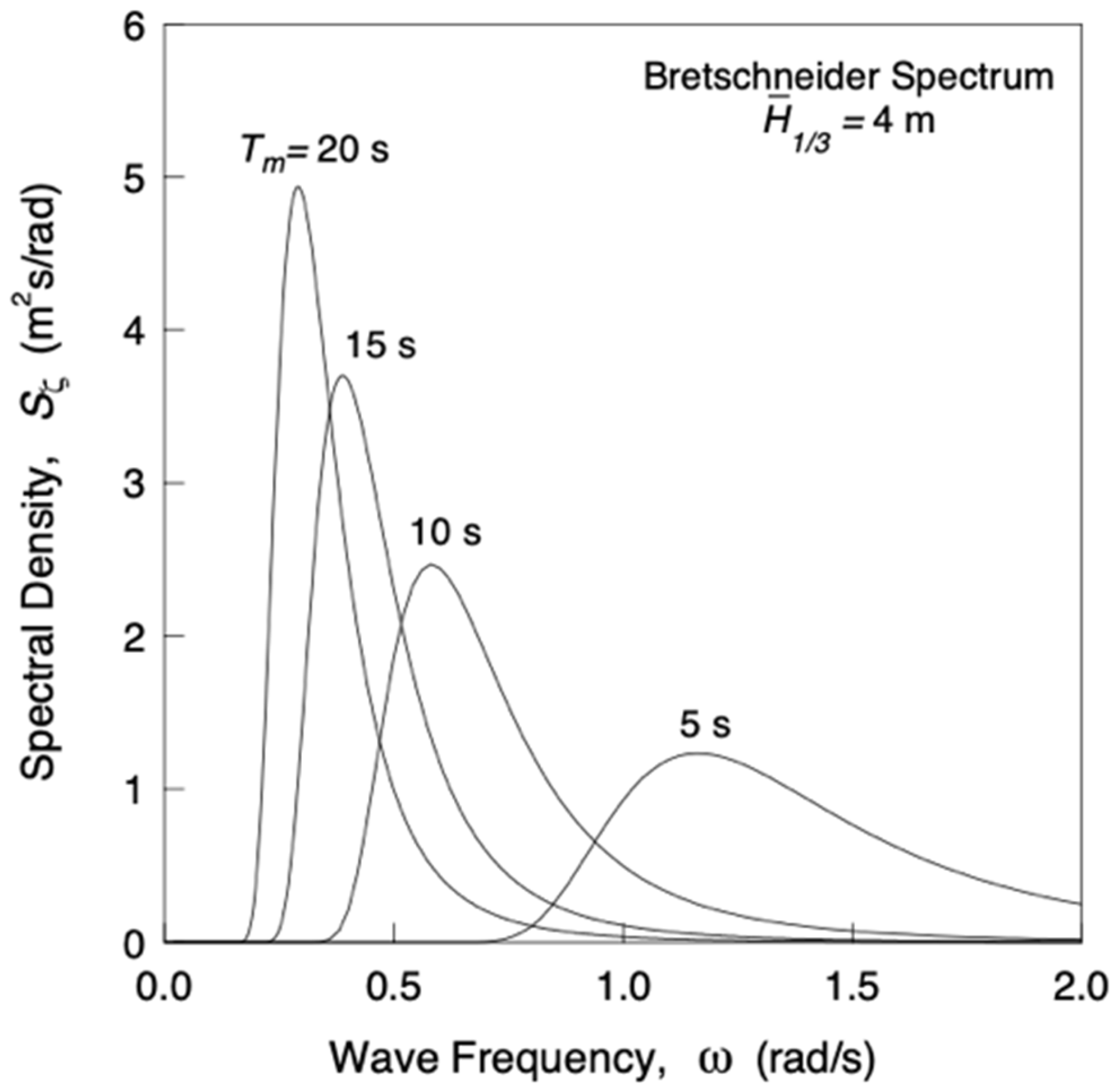


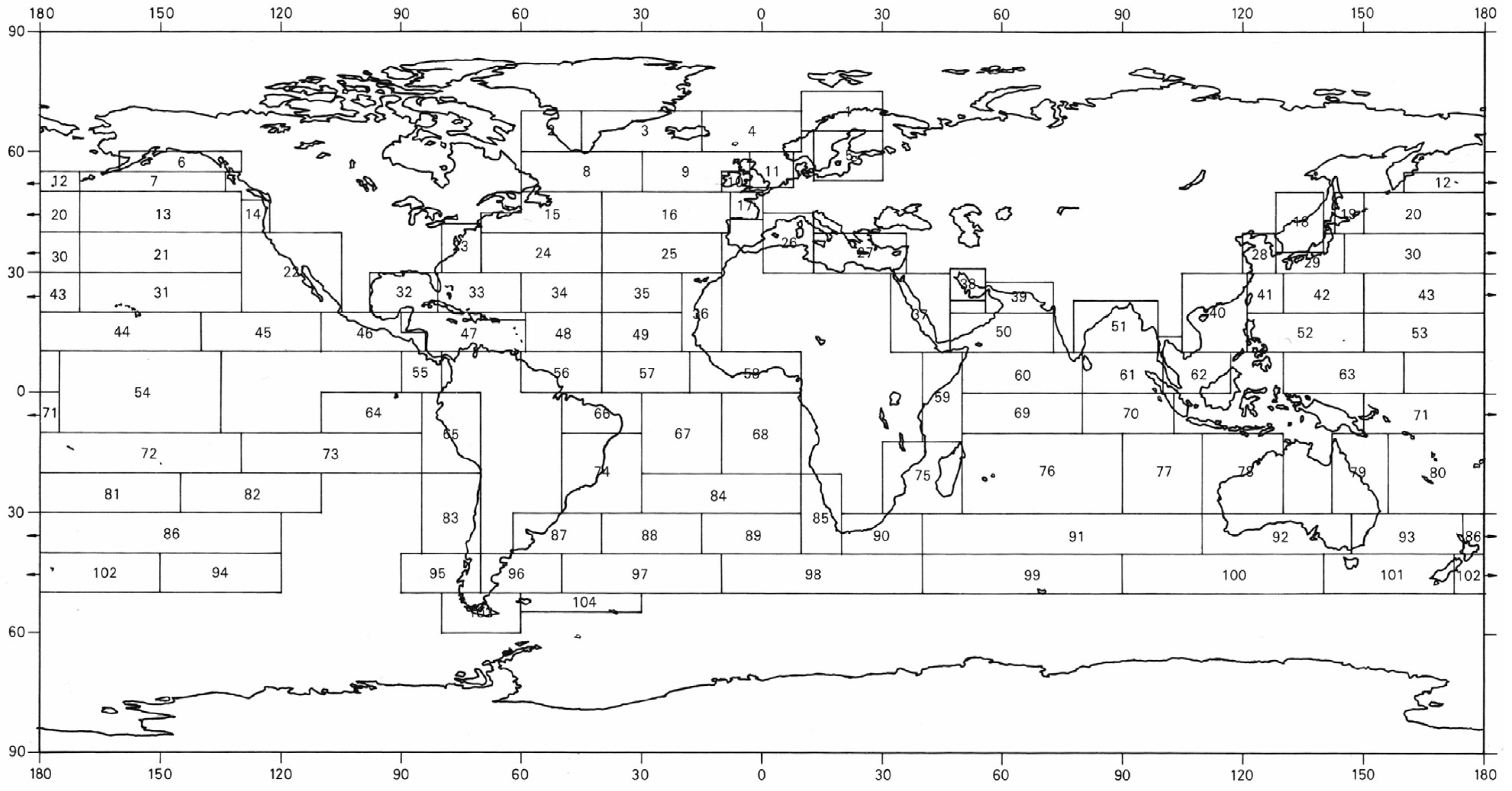
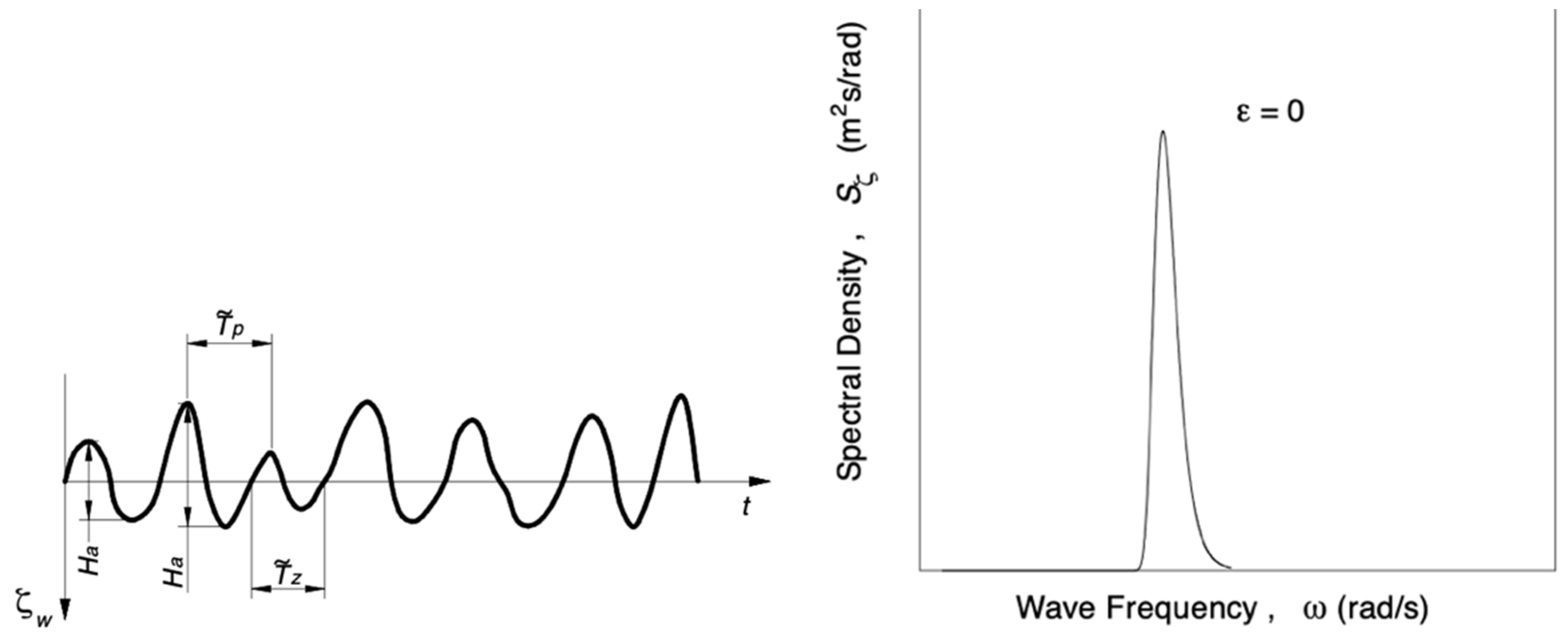

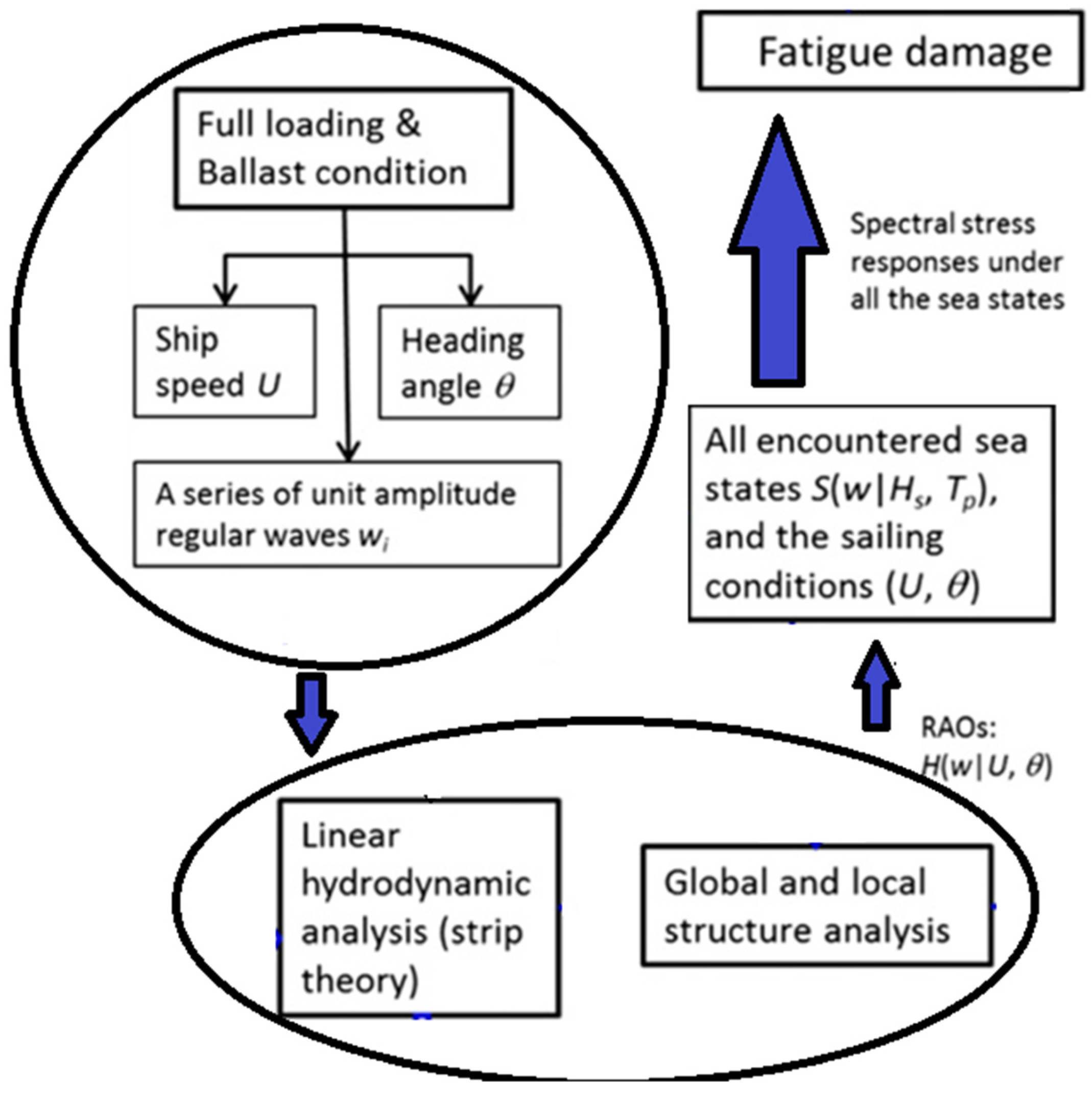

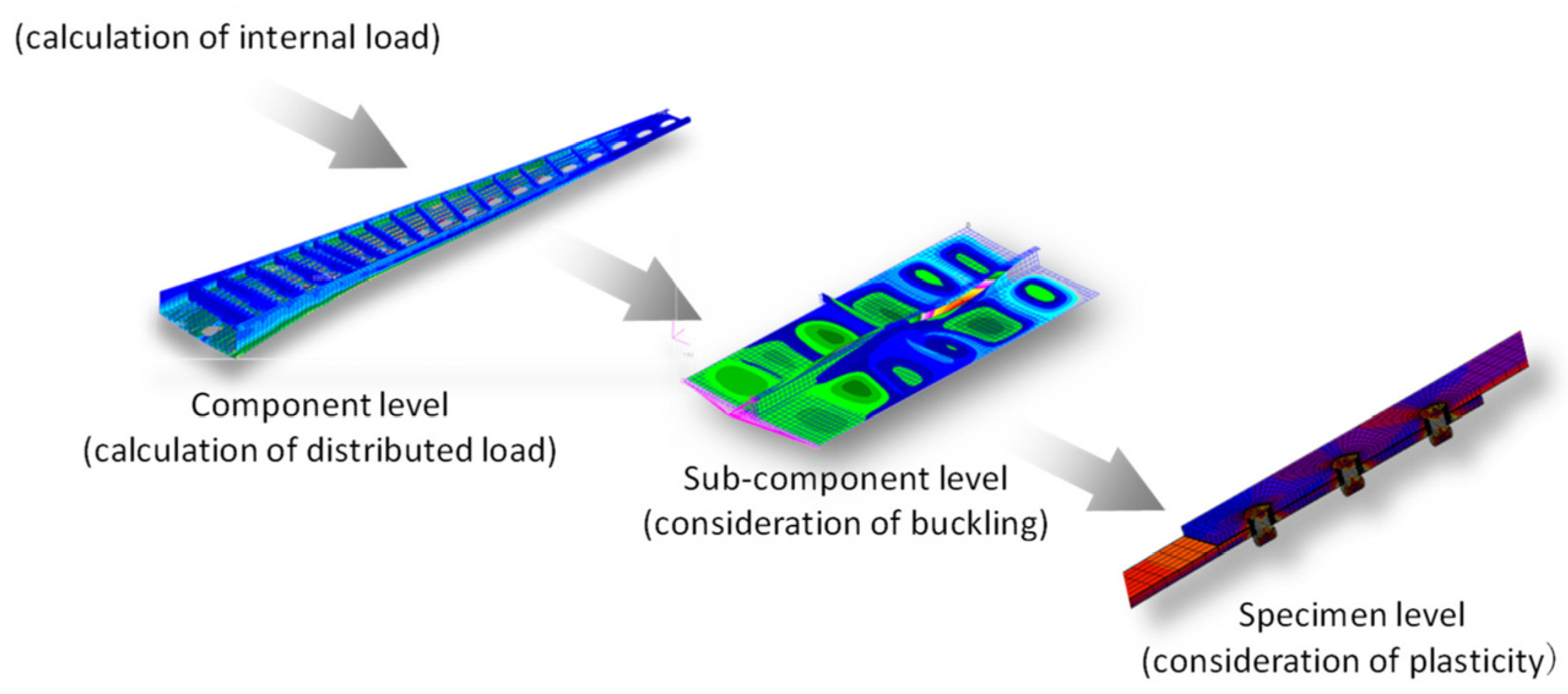
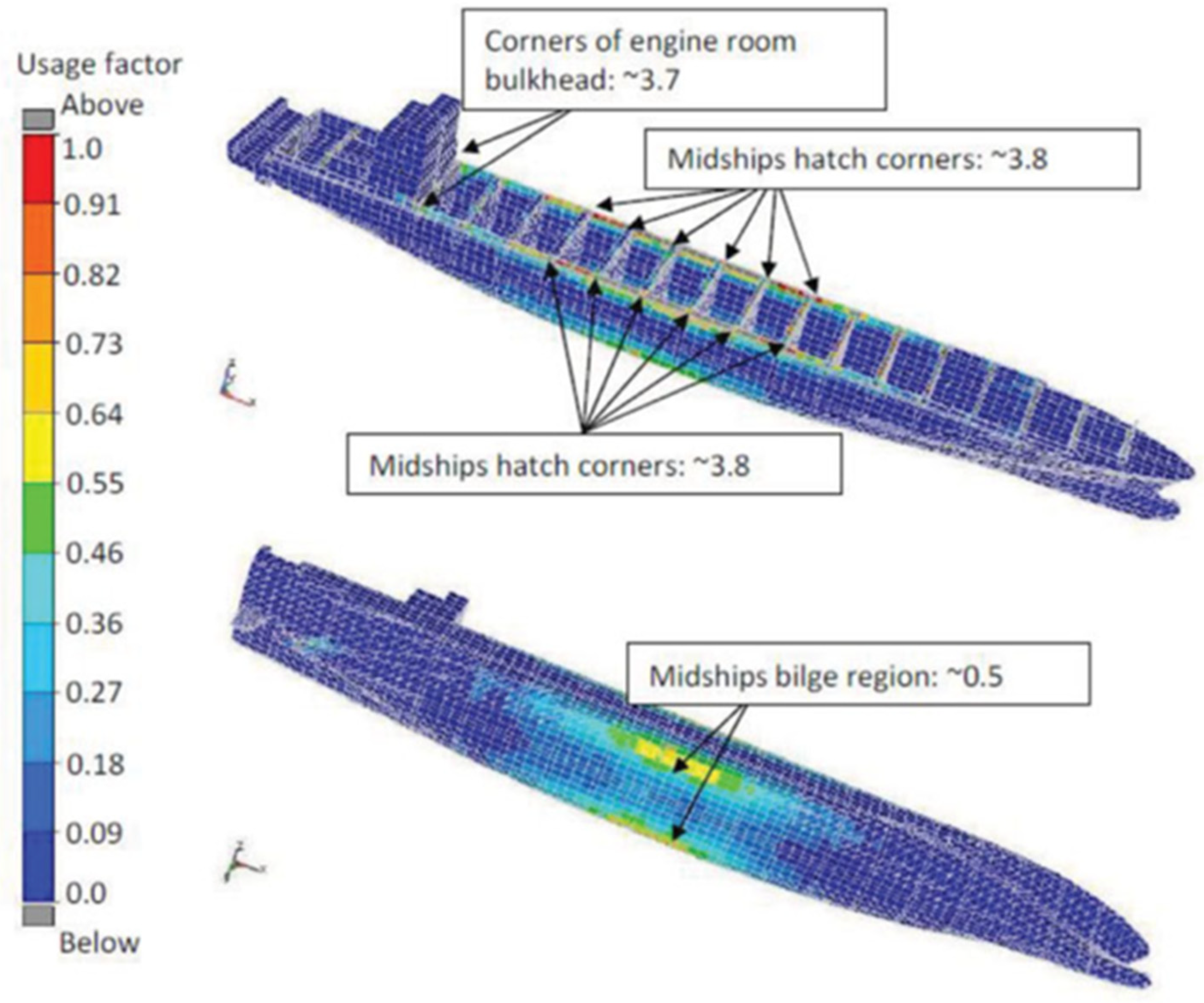
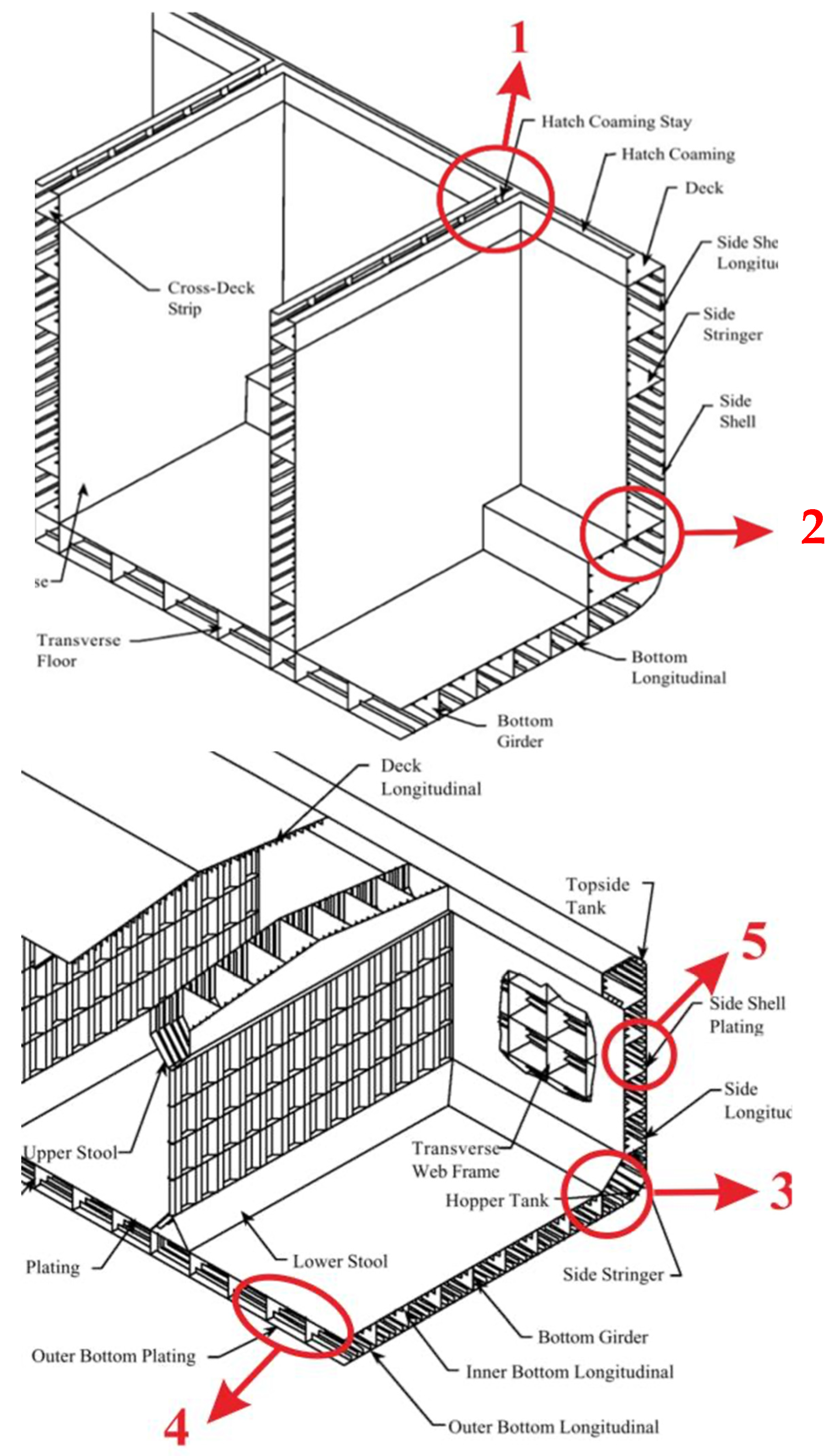
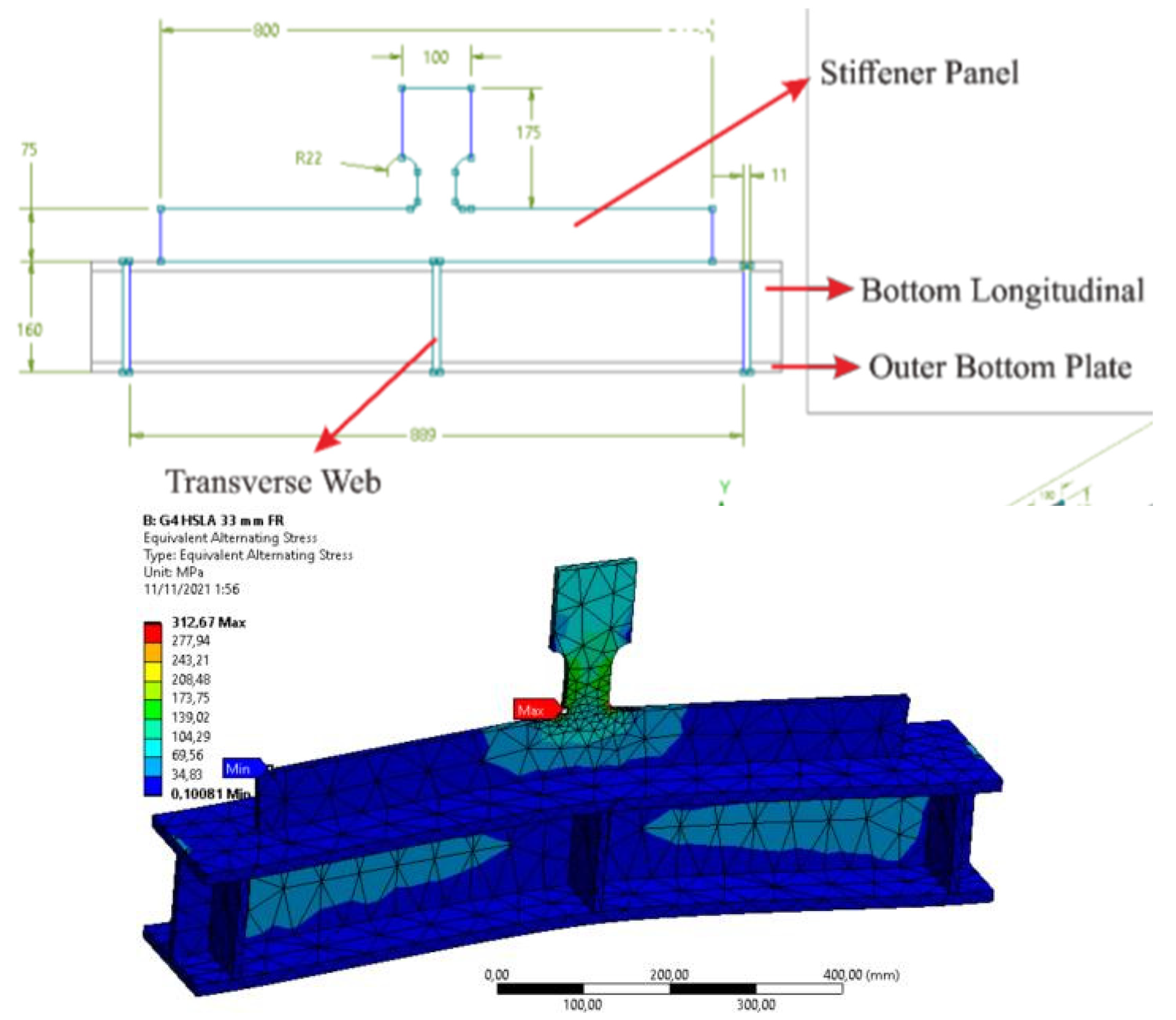
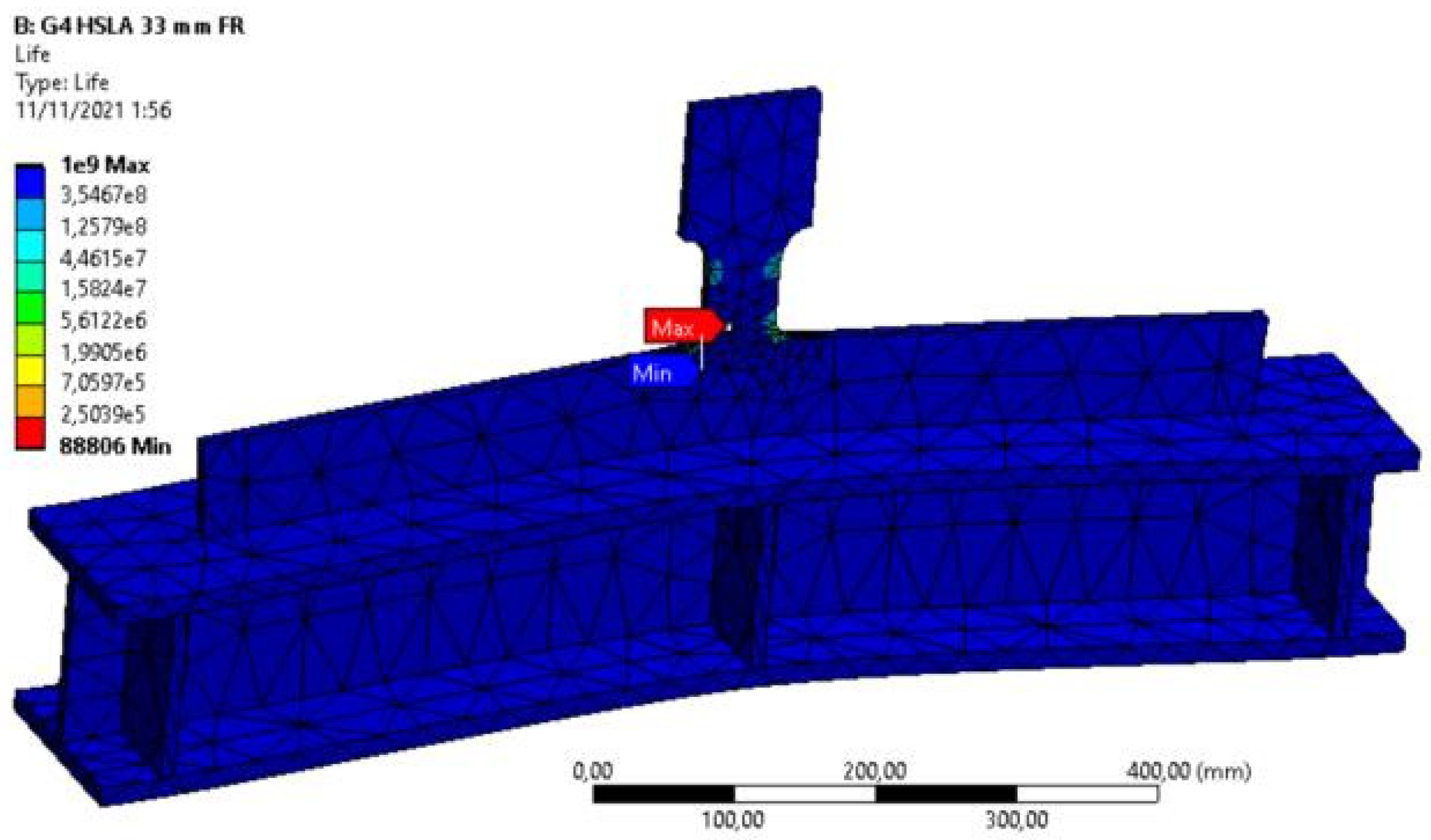


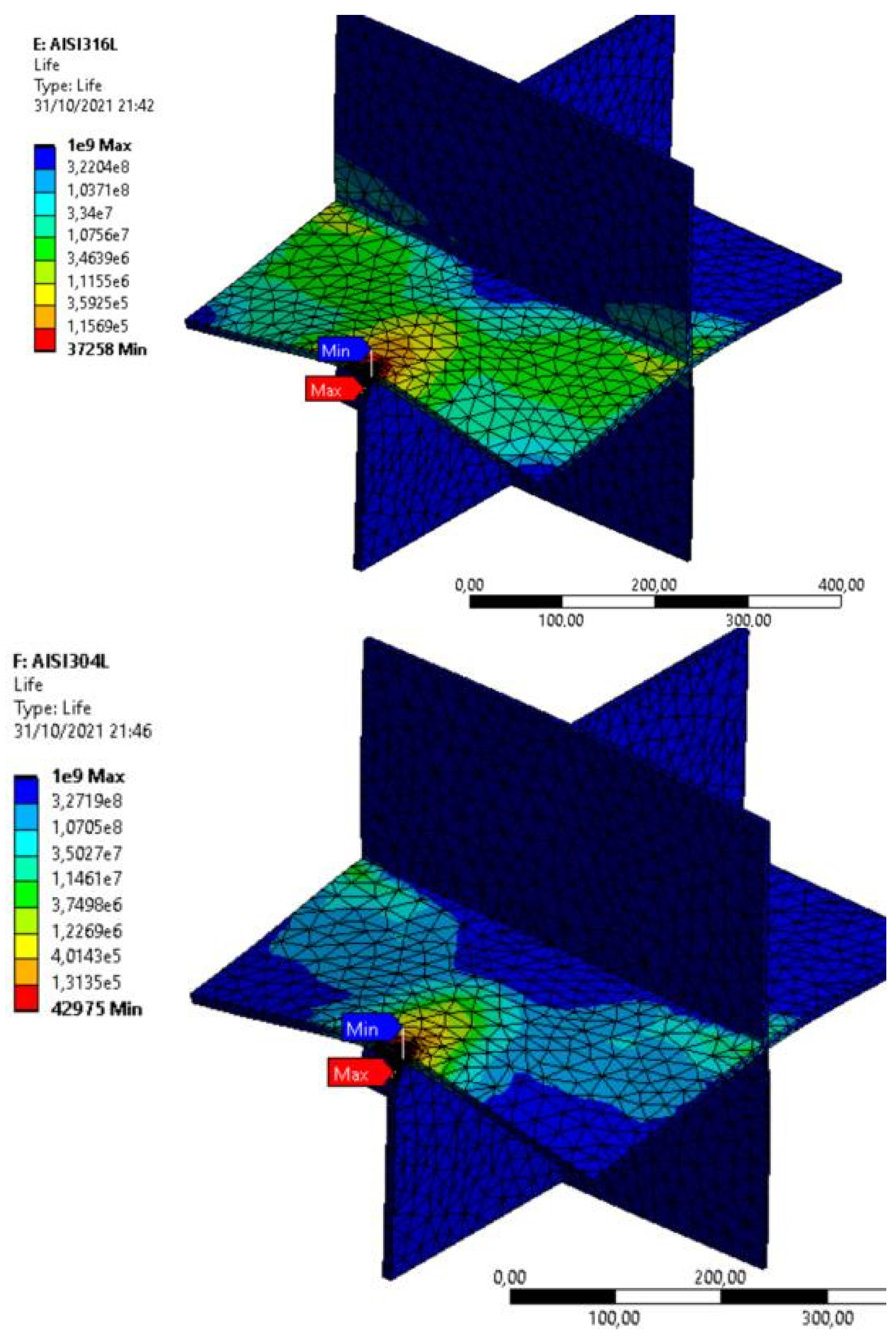
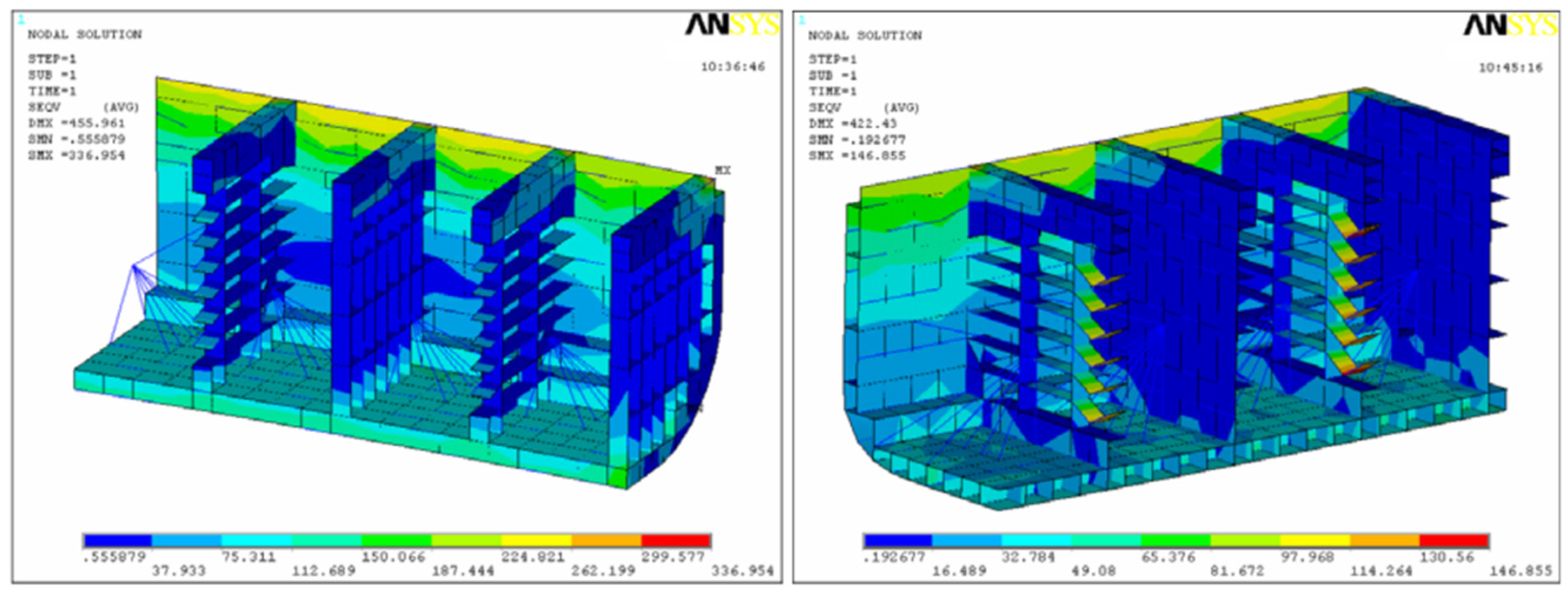

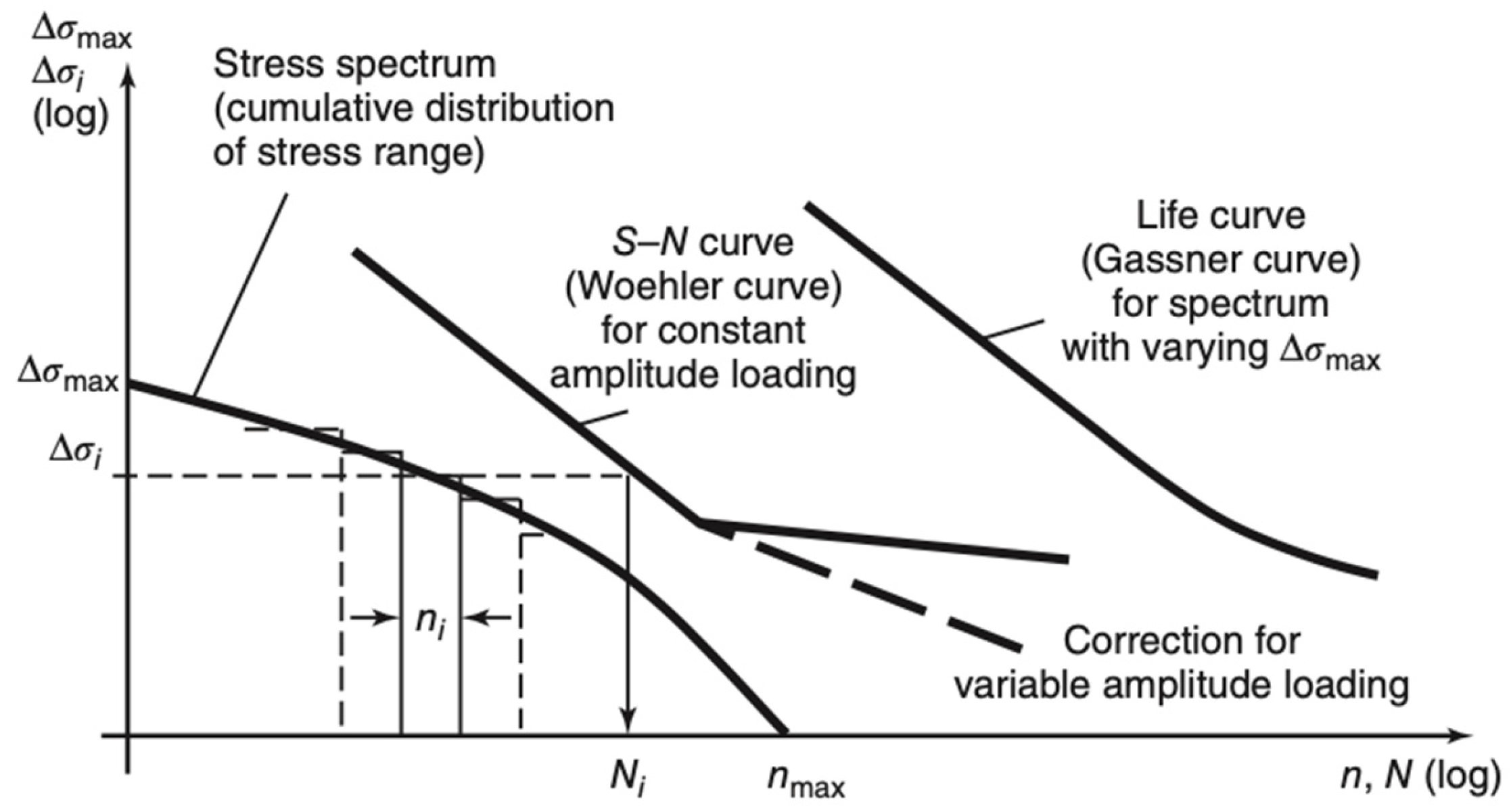
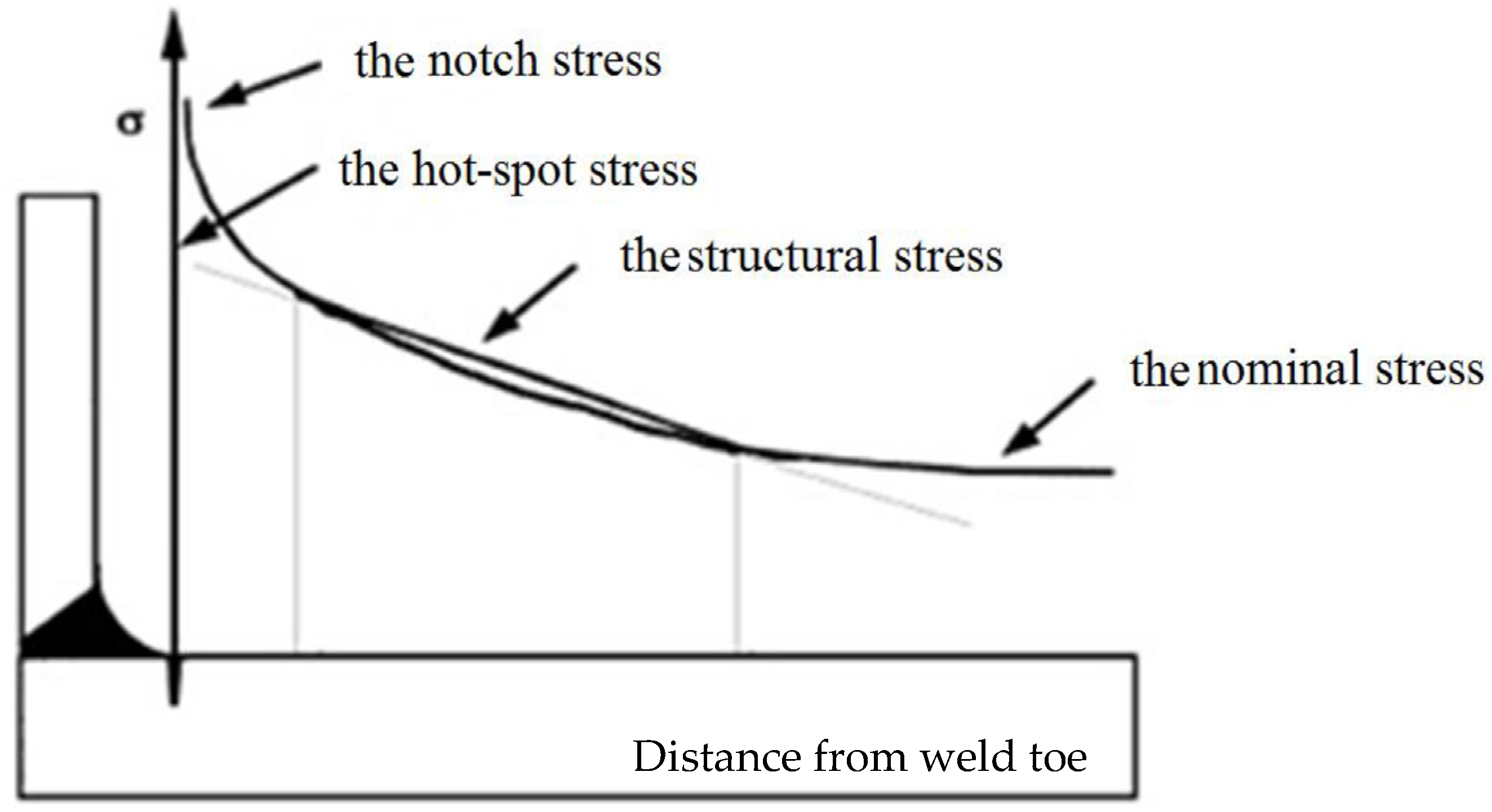
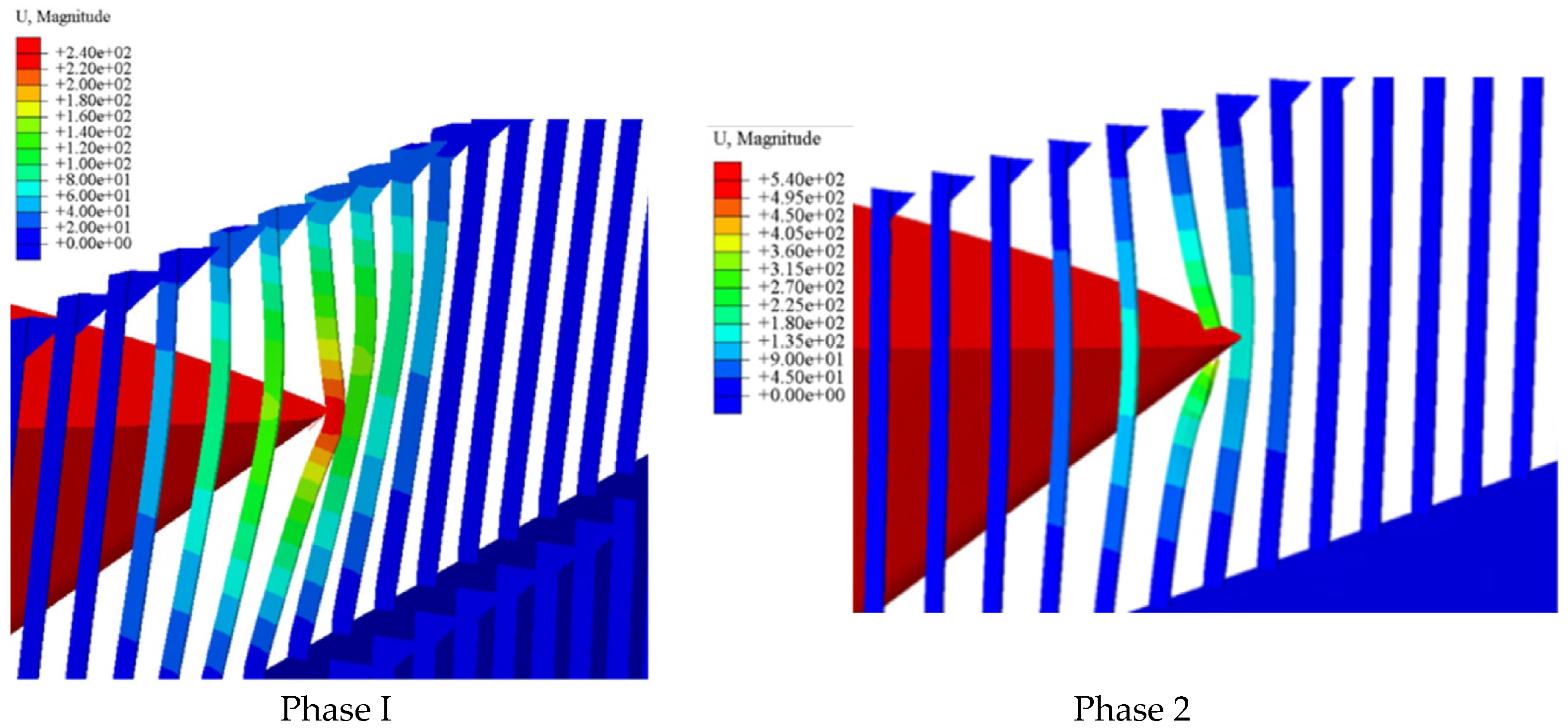

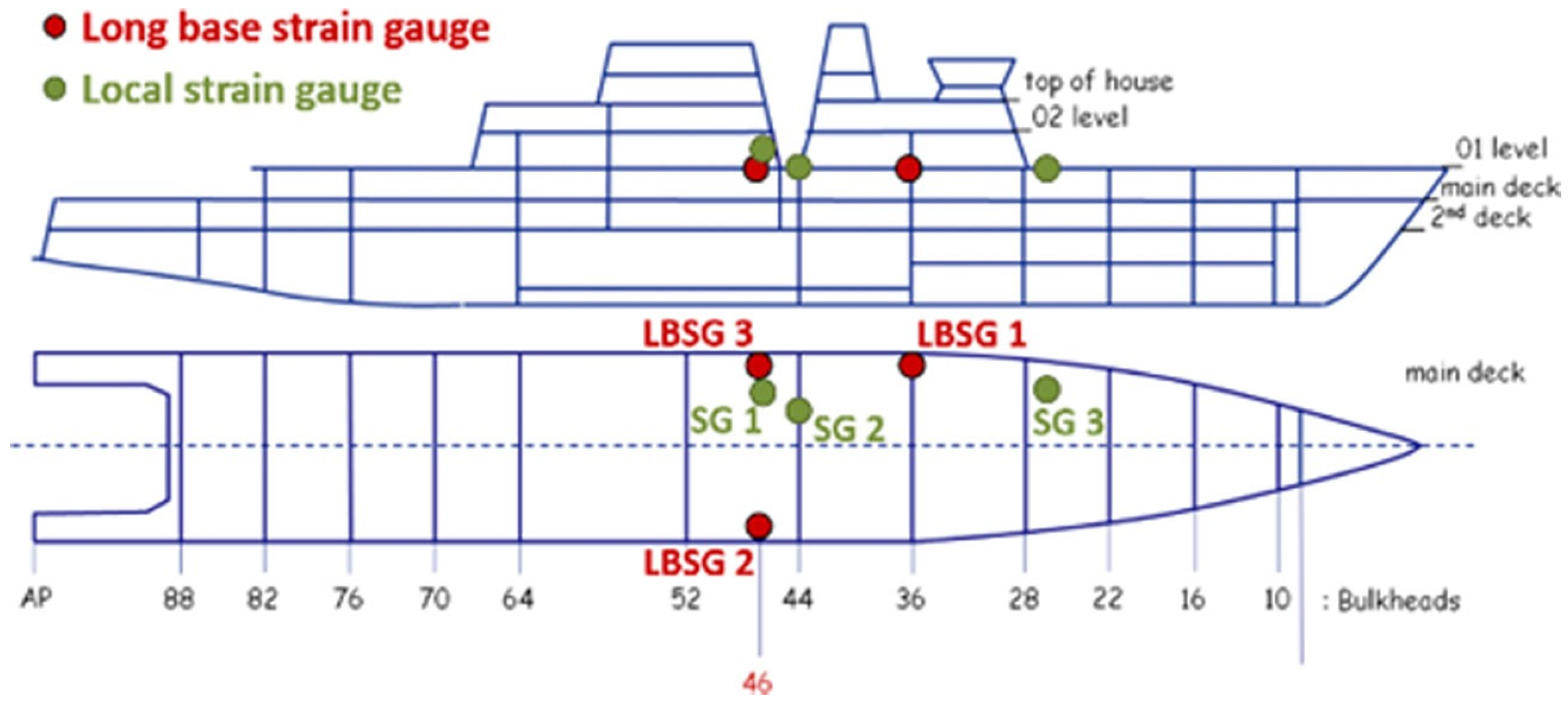
| Loading Type | Impact on the Structures |
|---|---|
| Hydrodynamic Loads (Propulsion Equipment on Hull) | Causes cyclic stresses that can lead to fatigue cracking in the hull, particularly near the propeller and shaft areas. |
| Loads Due to Varying Loading Conditions | Results in uneven stress distribution, increasing the risk of localised fatigue and potential structural failure. |
| Wave Loads | Induces cyclic loading that can cause progressive fatigue damage over time, especially in rough seas, leading to potential structural integrity issues. |
| Wave Spectrum | Pros | Cons |
|---|---|---|
| Pierson–Moskowitz | Represents fully developed seas based on wind speed. | Assumes idealised conditions (fully developed seas), which may not always match real-world situations. |
| Bretschneider | Widely used for representing general sea states (fully developed and developing or endangered sea). | Less accurate for very young or rapidly changing seas, as it doesn’t account for varying fetch and duration. |
| JONSWAP | Accounts for fetch-limited sea conditions, providing a more realistic representation of actual sea states. | More complex and requires additional parameters (like peak enhancement factor), making it less straightforward to use. |
| Fatigue Assessment Approach | Pros | Cons |
|---|---|---|
| Simplified Deterministic Method | Simplicity: Easy to use with straightforward calculations and fewer data requirements. | Oversimplification: May not capture complex load histories or stress distributions accurately. |
| Fast: Provides quick results, suitable for preliminary design and screening. | Limited Accuracy: May lack accuracy in predicting fatigue life for complex geometries or loading conditions. | |
| Standardisation: Often based on established guidelines and standards, making it widely accepted. | No Detailed Analysis: Does not consider dynamic effects or transient loading in detail. | |
| Cost-effective: Requires minimal computational resources and data. | Assumptions: Often based on simplifications and assumptions that may not apply to all scenarios. | |
| Direct Calculation Method (Time Domain) | Detailed Analysis: Provides a thorough analysis of the time history of loading, capturing transient effects. | Computationally Intensive: Requires significant computational resources, especially for long time histories. |
| Accuracy: Can model complex load histories and interactions between different loading components. | Data Intensive: Requires detailed and accurate input data, which can be challenging to obtain. | |
| Comprehensive: Allows for detailed evaluation of stress and strain responses over time. | Complexity: Can be complex to implement and interpret, requiring specialised knowledge and software. | |
| Versatility: Suitable for analysing real-world load conditions and dynamic effects. | Time-consuming: Computationally expensive and time-consuming, especially for large-scale models. | |
| Direct Calculation Method (Frequency Domain) | Efficiency: Can efficiently analyse cyclic loading and periodic signals using frequency-domain techniques. | Limited Scope: May not be suitable for non-stationary or highly transient loading conditions. |
| Simplifies Analysis: Useful for problems where load spectra can be represented as a sum of harmonic components. | Assumptions: Assumes linear elastic behaviour and may not accurately model nonlinear or complex responses. | |
| Fast Computation: Typically faster than time-domain methods for periodic or stationary signals. | Frequency-Dependent: Requires transformation from time-domain data to frequency-domain data, which may introduce errors. | |
| Linear Finite Element Analysis | Detailed Analysis: Provides detailed stress and strain distributions, useful for complex geometries. | Linear Assumptions: Assumes linear elastic material behaviour, which may not be accurate for all materials. |
| Versatility: Can model complex structures and loading conditions with high accuracy. | Complex Setup: Requires detailed modelling and meshing, which can be time-consuming and complex. | |
| Accuracy: Provides good results for linear problems and small deformations. | Limited for Nonlinear: Not suitable for problems involving significant plastic deformation or complex material behaviour. | |
| Nonlinear Finite Element Analysis | Complex modelling: Can model complex material behaviors, large deformations, and nonlinear effects. | Computationally Intensive: Requires significant computational power and time, particularly for large models. |
| Accuracy: Provides high accuracy for complex, real-world problems involving plasticity, damage, and more. | Complexity: More complex to set up and interpret, requiring advanced knowledge and expertise. | |
| Versatility: Can handle a wide range of loading conditions and material models. | Resource Demanding: Requires extensive computational resources and longer analysis times. | |
| Detailed Results: Offers a detailed analysis of the structure’s behaviour under various loading conditions. | Cost: Higher cost in terms of software, hardware, and analysis time. |
Disclaimer/Publisher’s Note: The statements, opinions and data contained in all publications are solely those of the individual author(s) and contributor(s) and not of MDPI and/or the editor(s). MDPI and/or the editor(s) disclaim responsibility for any injury to people or property resulting from any ideas, methods, instructions or products referred to in the content. |
© 2024 by the authors. Licensee MDPI, Basel, Switzerland. This article is an open access article distributed under the terms and conditions of the Creative Commons Attribution (CC BY) license (https://creativecommons.org/licenses/by/4.0/).
Share and Cite
Corigliano, P.; Frisone, F.; Chianese, C.; Altosole, M.; Piscopo, V.; Scamardella, A. Fatigue Overview of Ship Structures under Induced Wave Loads. J. Mar. Sci. Eng. 2024, 12, 1608. https://doi.org/10.3390/jmse12091608
Corigliano P, Frisone F, Chianese C, Altosole M, Piscopo V, Scamardella A. Fatigue Overview of Ship Structures under Induced Wave Loads. Journal of Marine Science and Engineering. 2024; 12(9):1608. https://doi.org/10.3390/jmse12091608
Chicago/Turabian StyleCorigliano, Pasqualino, Federico Frisone, Claudia Chianese, Marco Altosole, Vincenzo Piscopo, and Antonio Scamardella. 2024. "Fatigue Overview of Ship Structures under Induced Wave Loads" Journal of Marine Science and Engineering 12, no. 9: 1608. https://doi.org/10.3390/jmse12091608










